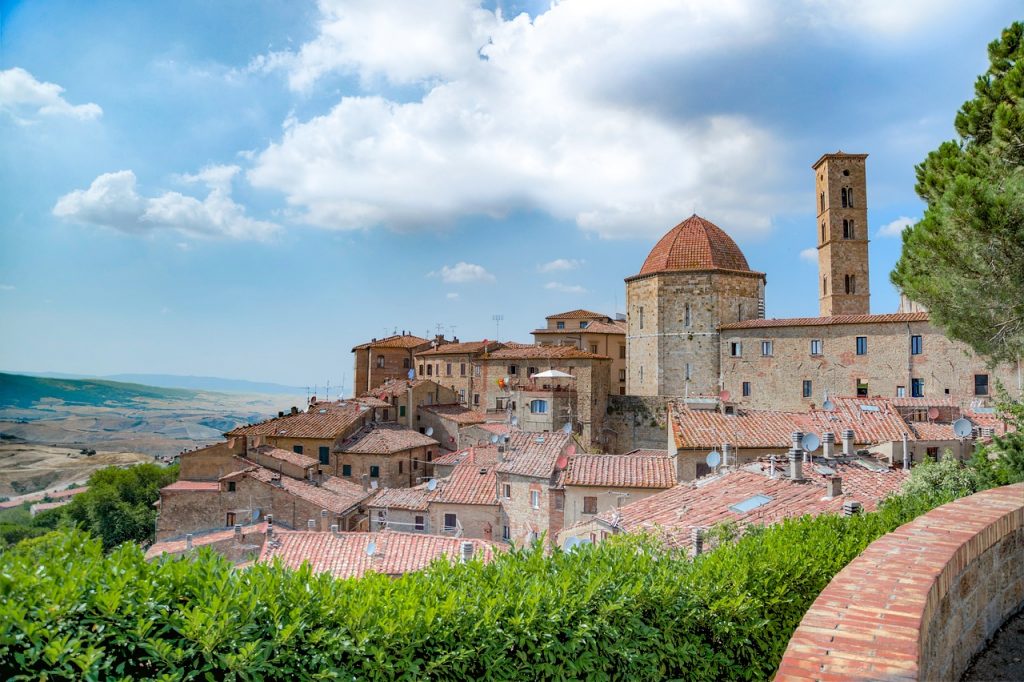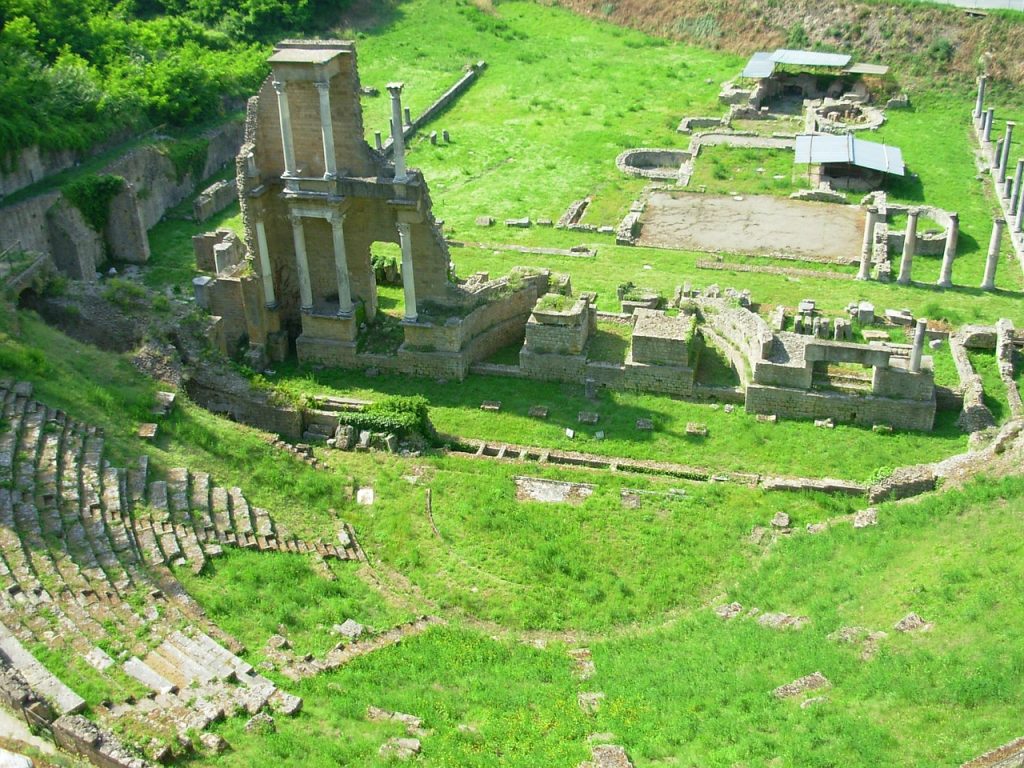Volterra in Tuscany, Italy, wasn’t always on the tourist trail. It was a blissfully quiet town in the province of Pisa that only passionate travellers ventured to. But nowadays, more and more people are discovering this charming hilltop town. Its Medieval town centre, gorgeous views, superb museums and friendly welcome are all part of the charm.
Perched on the Val di Cecina’s hills, Volterra is one of the most scenic walled Tuscan towns. It was a magical and atmospheric place even before Meyer’s Twilight saga put it on the map. Its impressive position is best appreciated arriving from Pisa, when you’ll see the ‘Balze’ – steep ravines that have been “eating” the town for centuries.
Volterra, Tuscany – The hilltop town with an Etruscan past
This town has a quietly evocative atmosphere. For some this comes from its Etruscan heritage, visible in the ancient Porta all’Arco and the Etruscan Museum Guarnacci, that has an impressive collection of Etruscan funerary urns and the famous statuette “Ombra della Sera“.
For others it’s the Medieval feeling of its stone alleyways and closely-packed buildings. The Piazza dei Priori is a magnificent example of a Medieval public space. And to add to its mysterious atmosphere, there’s the Rocca Nuova, a dominating Renaissance prison that’s still in use still today.
Easy to explore on foot, you’ll need a full day to appreciate all the sights of Volterra. The Cathedral with its rich late Renaissance interior is well worth a visit, and so is the Pinacoteca Art Gallery with a collection of Tuscan art that meanders through the 15th and 16th centuries.
There are green spaces too. The Park near the Fortress and the Roman Theatre, that has some of the best Roman ruins in the whole of Tuscany. => Follow our itinerary to organise your perfect day trip.

The town of truffles and alabaster
Volterra is also known for its alabaster workshops and white truffle festivals, one of the most important in Italy.
Volterra, Italy – What to see and do in Volterra
PIAZZA DEI PRIORI
Piazza dei Priori is the heart and soul of the town. A beautiful Medieval setting which makes you feel like you’ve stepped onto the set of a period film. The impressive Palazzo dei Priori is the oldest town hall in Tuscany, and this is where the political life of Medieval Volterra used to happen. It’s a space that oozes character and history, and puts on a lively market every Saturday.
PALAZZO DEI PRIORI and PALAZZO PRETORIO
The Palazzo dei Priori was the seat of local government, built in the early 13th century. The ‘priori’ who ruled the city used to live here for the duration of their office and were only allowed outside for special occasions. Visit the Council Hall or “Sala del Consiglio” with its cross vaulted ceiling. Then climb to the top of the tower for magnificent views of the surrounding countryside. You’ll see a collection of stone coats of arms in the courtyard and on the facade, which were typical of this kind of building. This is where the Florentine ruling families left their mark on Volterra in the 14th century.
The Palazzo Pretorio used to be the seat of the podesta’ in the Middle Ages. It’s formed by different buildings that were joined together in the 20th century. If you look up, you can see the little stone piglet perched near the top of the tower. This is probably the most ancient tower in Volterra, and is known as the “torre del porcellino”. Unfortunately, you can’t visit the interior of the palace.
=> Discover the Top 12 Hilltop Towns in Tuscany

GUARNACCI ETRUSCAN MUSEUM
History buffs should pay a visit to the Etruscan Museum. Volterra was one of the Etruscan city-states and this museum has an interesting collection of finds from nearby necropolises. It doesn’t offer much in terms of explanation in English, but it’s one of the most important Etruscan museums of its kind in Italy. Definitely worth a look.
The collection proceeds chronologically through different stages of Etruscan culture through to the Roman era. Funerary urns make up a big part of the exhibit, plus a great collection of Etruscan, Roman and Greek coins and some Roman mosaic floors.
PORTA ALL’ARCO – ETRUSCAN GATE
People have been using this door to enter Volterra since the 3rd century BC. It was the southern gate to the city, built in tufa rock and sandstone and adorned by three heads. What was the meaning of these heads? Most likely they represented the gods put there to protect the city and intimidate any unwanted visitors. An interesting fact about this ancient gate was that it managed to escaped destruction during the second world war. The citizens of Volterra saved it from German bombs by filling up the gate opening with stones taken from the streets.
⇒ One day in Volterra itinerary, discovering all the highlights.
CATHEDRAL AND BAPTISTRY
The Cathedral stands at the religious core of Volterra. From the outside it looks to be a modest edifice featuring a sombre Romanesque style. Inside however it guards precious works of art mainly from the late Renaissance era, while the bell tower is 14th century. Admire the glorious coffered ceiling, the marble pulpit, an elegant ciborium by Mino da Fiesole (1471), and a masterpiece of Romanesque wooden sculpture (“Deposition”, 1228). This is the oldest work in the Duomo, a curious piece that shows Jesus being taken down from the cross.
The 13th century Baptistry, with its typically octagonal shape, stands in front of the Cathedral. There’s a simple Romanesque exterior, and inside a baptismal font by Giovanni Vaccà (1759).
PINACOTECA and MUSEO CIVICO
Hosted in the elegant Palazzo Minucci-Solaini, the Pinacoteca of Volterra is famous in Italy for the “Deposition” by Rosso Fiorentino (1521). With striking colours and an impressive composition, this painting is typical of the early mannerist style. Many art lovers come to Volterra just to see this masterpiece. The other highlights within this collection of Tuscan paintings are works by Luca Signorelli, Taddeo di Bartalo and Ghirlandaio.
ROMAN THEATRE
Volterra was a vibrant city in the 1st century BC. And this was the Roman theatre donated to the city by the prominent local family of the Caecina. The semi-circular seating was built directly into the hill and you can still make out the radial stairways today. At the foot of the benches was the “orchestra” where the high-ranking spectators would sit. The theatre was active until the 3rd century when it was abandoned. A bathhouse was built to the rear, using stones from the ruined theatre.
You can pay to visit it or see the panorama from the street above it.
=> 8 Inspiring Places in Tuscany that will Spark your Imagination!
=> Are you an art passionate? Do you love nature and food? Here you can find some Tuscany itineraries made for your interests.

ALABASTER SHOPS
Alabaster is the local stone that master artisans have been working for centuries in Volterra. A walk around the city will immediately give you an idea of how relevant this artisan tradition is here. The Etruscans were already using this luminous, translucent and soft stone to create urns, vases and sculptures. After centuries, the tradition is kept alive by skilled artisans that create magic and modern objects in their botteghe filled with fine white dust.
There’s also an Eco-Museum of Alabaster where you can learn more about this unique tradition.
VOLTERRA CARD: The Volterra Card can be purchased at the ticket office in one of the museums and is valid for 72 hours: 15 €, free for kids under 6 years of age.

Where is Volterra, Tuscany?
Volterra is in the Val di Cecina between Florence, Pisa and Siena. (Firenze: 70 km; Siena: 47 km; Pisa: 63 km; S.Gimignano: 29 km). It takes an hour and a half to drive from Pisa or Siena, and a bit longer from Florence. The drive from Montespertoli to Volterra is particularly scenic.
Explore some original driving itineraries that include San Gimignano and the ‘Balze’ cliffs of Volterra.
⇒ If you only have a day, should you explore Volterra or the famous San Gimignano? Here’s a few tips to help you decide.

Did you know? Volterra in novels and on the screen
Writers and directors have also been inspired by Volterra. Stephenie Meyer set some scenes of the Twilight saga here, but the film based on the novel was really filmed in Montepulciano.
Only for vampires’ fans! => Originally, Stephenie Meyer planned to have the Volturi live in Tuscany, in a fictional city called “Volturin”. She found out that a town named Volterra existed, with a clock tower like the one she had invented for her city. And that’s how vampires came to live in Tuscany, Italy.
Volterra has been chosen to serve as a background in some of the scenes in the Netflix series of the Medici.
⇒ Learn what the second season of the Medici serie is about.

